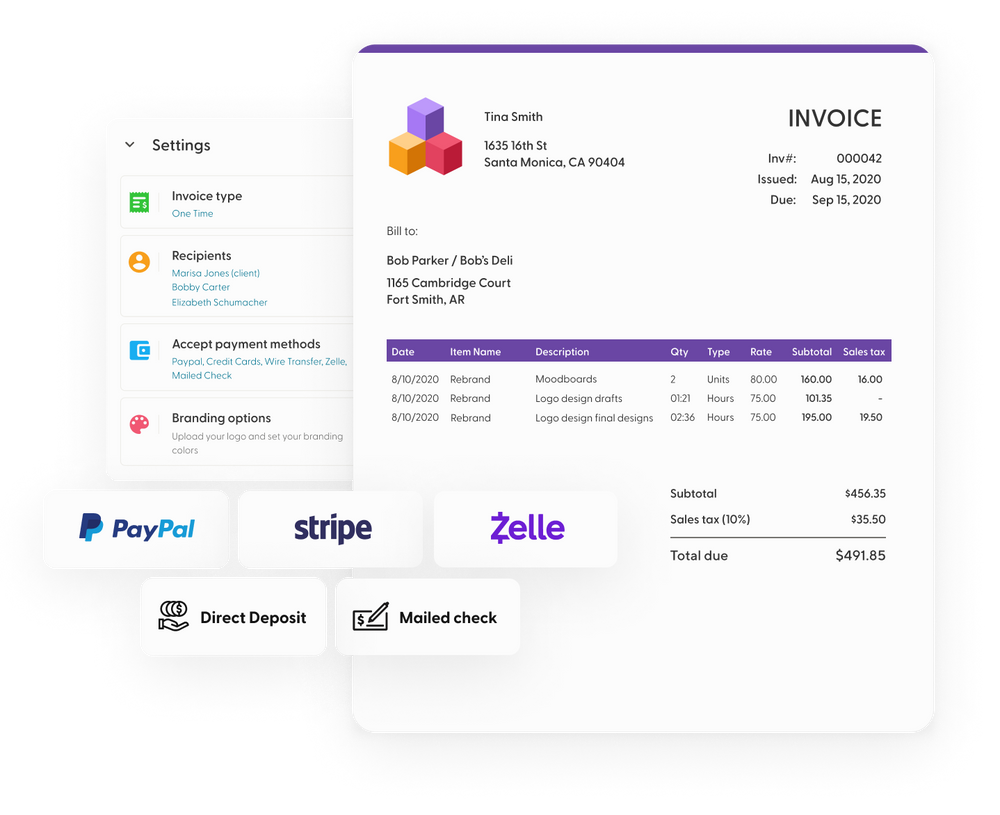Knowing how to properly invoice clients is an important skill to have as a freelancer. You want to make sure that you’re communicating all the right information so that you can get paid as quickly as possible - without any reason to go back and forth with your clients in the process.
In this article, we’ll share all the information that needs to be included on invoices as well as some additional information around the invoicing process.
What to Include in an Invoice
There are many things to include within an invoice to make sure the client has all the information needed and to keep records for yourself. Be sure your invoice has these essentials:
- Your Company Name/Address: This is pretty self-explanatory. Putting your company name (even if it’s just your name) and address lets your client know who the invoice is going to. This is also important if it’s being circulated internally.
- Client’s Name and Address: Include your client’s name and address for your records and to address the client.
- Invoice Number: This makes it easy to keep track of your invoices and communicate about them effectively with your client
- Invoice Date: The invoice date is the day that you send your invoice to the client. This can correlate with your due date, depending on your terms, especially if it’s net X days
- Due Date: The due date is when the payment is due. This is often within seven to thirty days of the invoice date.
- Payment Terms: The standard payment terms are repayment within a certain time window. This often ranges from seven days to thirty days. Payment terms may also include information around a late fee or interest incurred after the due date passes. If your client doesn't pay you on time, we've written an article on how to politely ask for payment.
- Payment Methods Accepted: Including what payment methods you accept is a helpful way to make sure you get paid promptly and in your preferred manner. Different payment methods can include: check, PayPal, Zelle, Stripe, deposit, or many others. Make sure that if there’s a processing fee, you discuss with your clients who’s responsible for that fee.
- Itemized List of Services: One of the most important items to include is an itemized list of services. You need to be specific on what you accomplished during this time. Whether this is a breakout of the different hours you’ve worked and what was accomplished or the specific deliverables you provided, this will validate what you are requesting payment for.
Invoicing Tools
Invoicing tools simplify the invoicing process. There are many types of invoicing tools out there. Some are catered specifically to invoicing, others to invoicing and time tracking. Choosing a tool that’s best for your needs and within your budget, will help you scale your invoicing processes and help organize your business.
Tips for Invoicing Clients
If you’re new to invoicing and billing clients, it can take time to get it down to a science. These tips can help.
Invoice Frequently
You want to make sure you’re invoicing frequently and not consistently having a large number of hours build up. If it’s an ongoing project, typical payment terms are biweekly. If you’re invoicing on a per-project basis, invoice as soon as the project ends. You want to be top of mind for clients and not have them need to think back to what they’re paying you for.
It also helps to create reminders in your calendar as to when to bill each client. Your clients could all have different invoice schedules, for example, one might want to be invoiced weekly, another monthly, and another at the end of every project. Try not to forget or delay your invoicing process. It's common to invoice at a minimum monthly to keep things on track and to support your business.
Have a Strong Payment Policy
When signing on with a client, ensure they agree to your payment policy in advance. Without this, problems around payment can happen. Your policy should dictate a payment deadline, as well as what will happen if there is a case of nonpayment. It’s crucial you deal with these potential errors ahead of time, so as to avoid awkward or difficult conversations in the future.
Sometimes a client will have their own payment policy that they will ask you to adhere to. Sometimes this is beneficial as it makes things easier on your end, and sometimes it's annoying. Understand when it makes sense to push back and when it makes sense to go with the flow.
Don’t Be Afraid to Follow Up
Don’t be scared to follow up! If a client is late with a payment, simply send a polite email reminder. It doesn’t have to be forceful or rude, it just has to be a little reminder that they are overdue. Don’t do it halfheartedly though, as this could create a potential pattern of late or missing payments. If a client is giving you the runaround, then you can get firm with them. Specify in your communications when you have to be paid by them.
Escalate When it’s Necessary
If a client refuses to pay - don’t panic. It might need some legal action if they continue to refuse to pay you, but this doesn’t have to be a scary process. A lawyer can write a certified letter and threaten legal action. Generally, this tactic encourages a client to pay, even if they are more than unwilling.
Mastering the Art of Invoicing
Invoicing and learning how to bill a client can seem daunting, especially when you’re starting out as a freelancer. By following these steps, you can make invoicing an easier process. By keeping track of your invoices, making sure your records are correct, chasing when necessary, and maintaining a good relationship with your clients, you will have an easy time getting paid. And remember - invoicing doesn’t have to be a harsh part of freelancing, it’s merely a way for you to get paid for what you do.




